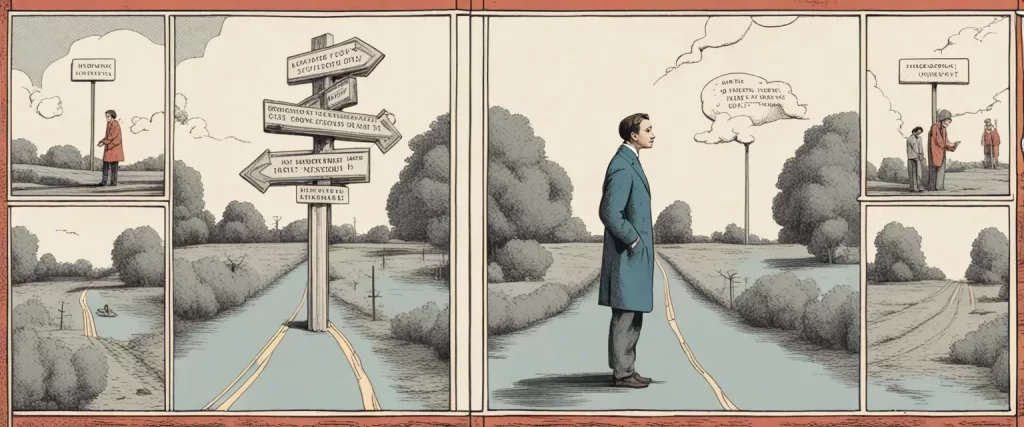——Good to Great by James C. Collins & The Innovator’s Solution by Clayton M. Christensen
In the ever-changing landscape of business and management literature, numerous books have emerged as influential guides for leaders and executives seeking growth, success, and sustainable competitive advantage. Two such works, “Good to Great” by James C. Collins and “The Innovator’s Solution” by Clayton M. Christensen, stand out as seminal works in their exploration of strategies for achieving organizational greatness.
“Good to Great,” published in 2001, presents a comprehensive analysis of what sets exceptional companies apart from their average counterparts. James C. Collins, a renowned business consultant and researcher, embarked on a rigorous study to identify the key factors contributing to sustainable excellence. On the other hand, “The Innovator’s Solution,” published in 2003 by Clayton M. Christensen and Michael E. Raynor, delves into the realm of innovation and provides insights into disruptive technology and market strategies.
While both books offer valuable perspectives on achieving organizational success, they approach the topic from distinct angles. Collins focuses on identifying the commonalities shared by companies that have transitioned from being merely good to achieving true greatness and examines the underlying principles that drive sustainable success. Christensen, on the other hand, explores the notion of disruptive innovation and provides a framework for identifying market disruptions and developing effective strategies to address them.
Despite their divergent focuses, a comparative study of “Good to Great” and “The Innovator’s Solution” promises to shed light on the intricate interplay between sustained excellence and disruptive innovation in the business world. By examining the synergies and implications of their methodologies, this study aims to extract valuable lessons that can be applied in leadership and organizational contexts.
In the pages that follow, we will delve deeper into the core concepts and theories presented by Collins and Christensen, analyze the underlying assumptions of their approaches, and explore how their ideas complement or diverge from one another. By doing so, we seek to equip leaders and managers with an enhanced understanding of the integral components for achieving greatness and fostering innovation within their organizations.
Through a comparative examination of “Good to Great” and “The Innovator’s Solution,” this study aims to stimulate a thought-provoking discussion on the various strategies employed by successful companies. By analyzing the commonalities and divergences of their recommendations, we aim to guide readers toward a comprehensive understanding of the intricacies involved in achieving sustainable excellence and fostering innovation in today’s rapidly changing business environment.
Now, let us embark on this comparative study as we uncover the valuable insights and practical lessons offered by Collins and Christensen, pioneering thinkers in their respective fields.
Brief Summary of Two Books
Good to Great by James C. Collins
Good to Great” by James C. Collins is a management book that analyzes how certain companies managed to transition from being merely good to achieving long-term greatness. The book’s main conclusion is that greatness is not the result of a single defining event but rather a series of disciplined actions taken consistently over time. Collins and his research team identified eleven companies that went through this transition and compared their strategies and practices with those of similar but less successful companies. Through this analysis, Collins outlines several key concepts for achieving greatness.
The book emphasizes the importance of assembling the right people on the team and placing them in the right positions, as well as confronting difficult realities without losing hope or becoming complacent. It highlights the need to develop a clear and sustainable business concept, focusing on what a company can potentially be the best in the world at. Additionally, Collins emphasizes the importance of maintaining discipline, rejecting excessive bureaucracy, and cultivating a culture of excellence and accountability.
Collins introduces the concept of the “Hedgehog Concept” as a key driver of greatness, which involves finding the intersection between what a company can be the best at, what it is passionate about, and what drives its economic engine. The book also stresses the importance of continually evolving, embracing technology and adapting to changing circumstances.
“Good to Great” provides insights into the factors that differentiate successful companies from their competitors and offers principles that leaders can apply to their organizations to foster long-term greatness.
The Innovator’s Solution by Clayton M. Christensen
The Innovator’s Solution” by Clayton M. Christensen is a strategic guide that addresses the challenge of sustaining growth in companies. The book builds upon Christensen’s previous work, “The Innovator’s Dilemma,” and offers practical advice for business leaders on how to successfully navigate disruptive innovation.
The central premise of the book is the concept of “disruptive innovation,” which refers to the transformation of industries through the introduction of new technologies or business models that redefine existing markets. Christensen argues that many established companies struggle to capture the opportunities presented by disruptive innovations due to their focus on the needs and preferences of their existing customers. This opens up opportunities for new, agile players to gain a foothold in the market and eventually disrupt incumbents.
“The Innovator’s Solution” provides a roadmap for companies to embrace disruptive innovation rather than fall victim to it. Christensen explains that successful innovators start by carefully understanding the jobs that customers want to accomplish, as opposed to focusing solely on improving existing products or services. By identifying the underlying needs and motivations of customers, companies can create innovative solutions that address these unmet needs.
The book also emphasizes the importance of creating a culture of experimentation within organizations. Christensen argues that companies need to be willing to take risks and try out new ideas, even if they may initially seem counterintuitive or threaten the status quo. This mindset allows organizations to continuously learn, adapt, and iterate their offerings in response to market changes and emerging opportunities.
The Innovator’s Solution” also highlights various strategies for successfully navigating disruptive innovation, such as creating separate business units or spin-off companies to explore new markets, leveraging emerging technologies to deliver products or services in novel ways, and adopting a modular approach to product development that allows for continuous improvement and adaptation.
Overall, “The Innovator’s Solution” provides practical guidance for business leaders who seek to understand and harness the power of disruptive innovation. By embracing change, adopting a customer-centric approach, and fostering a culture of experimentation, companies can not only survive but thrive in an ever-evolving marketplace.
Comparison between Two Books

Similarities in Management
Both “Good to Great” by James C. Collins and “The Innovator’s Solution” by Clayton M. Christensen explore the topic of management and provide insights into how to achieve success in business. Here are some similarities in their approaches to management:
1. Emphasis on leadership: Both books emphasize the significance of exceptional leadership in driving organizational success. They underline the importance of having visionary leaders who can set clear goals, inspire their teams, and make tough decisions.
2. Focus on long-term thinking: Both authors stress the importance of long-term thinking in management. They argue that short-term fixes and quick fixes often lead to mediocre results. Instead, they advocate for sustained efforts and investments in order to achieve long-lasting success.
3. Importance of data-driven decision-making: Both books advocate for decision-making based on objective data and analysis. They argue that relying on gut feeling or anecdotal evidence can be risky, and it’s crucial for managers to gather and analyze relevant data to make informed decisions.
4. Adapting to change: Both Collins and Christensen emphasize the need for companies to adapt and evolve in response to changing market dynamics and customer needs. They suggest that organizations should be willing to critically evaluate their existing strategies, develop a culture of experimentation, and be open to disruptive innovations.
5. Building a sustainable competitive advantage: Both books stress the importance of developing and maintaining a sustainable competitive advantage. They explore different aspects of competitive advantage, such as focusing on core competencies, leveraging technology, and continuously innovating to stay ahead in the market.
6. Putting people first: Both authors emphasize the importance of valuing and developing human capital. They argue that building a culture of excellence and retaining talented individuals are key to long-term success. Both books encourage managers to focus on hiring the right people, providing them with meaningful work, and creating an environment where they can thrive.
Overall, both “Good to Great” and “The Innovator’s Solution” highlight the significance of effective leadership, long-term thinking, data-driven decision-making, adaptability, competitive advantage, and the value of people in achieving managerial success.
Divergences in Management
Both “Good to Great” by James C. Collins and “The Innovator’s Solution” by Clayton M. Christensen are highly regarded books that provide valuable insights into improving business performance and leadership. While they do share some similarities, there are significant divergences when it comes to their perspectives on management.
1. Focus on Different Types of Companies:
– “Good to Great” primarily focuses on identifying commonalities among companies that went from being good to truly great over a sustained period. Collins and his research team examine how these companies achieved long-term success through key leadership principles and disciplined management practices.
– “The Innovator’s Solution” focuses on disruptive innovation, primarily in the technology industry. Christensen delves into the concept of disruptive innovation and provides strategies for managing and responding to disruptive forces that can greatly impact businesses.
2. Time Horizon:
– Collins focuses on long-term success, emphasizing the need for sustained excellence over an extended period. He explores the Stockdale Paradox, which highlights the importance of confronting the brutal facts while maintaining unwavering faith in the ultimate success of the company.
– Christensen, on the other hand, addresses both short-term and long-term strategies. He emphasizes the need for companies to allocate resources differently and to balance innovation with existing operations. Christensen suggests that companies should strive to create a portfolio of innovations to cater to both current and future market needs.
3. Leadership Styles:
– Collins advocates for Level 5 Leadership, characterized by humility, determination, and a focus on the organization’s success rather than personal ambition. He highlights the importance of leaders who are willing to make difficult decisions and set the company up for long-term success.
– Christensen recognizes the importance of leadership but also emphasizes the role of innovation in driving success. He encourages a more decentralized approach to leadership, where frontline employees are empowered to take risks and experiment with new ideas. Christensen suggests that leaders should create a culture that fosters disruptive innovation.
4. Strategic Decision Making:
– Collins believes in the concept of the Hedgehog Concept, which focuses on finding the intersection of what a company is deeply passionate about, what it can be the best at, and what drives its profit engine. Strategic decision making in “Good to Great” is centered around aligning these three core elements.
– Christensen argues that sustaining innovation requires a different set of processes and approaches compared to disruptive innovation. He advises companies to create separate divisions or teams dedicated to disruptive projects, allowing them to operate autonomously and avoid suffocating bureaucracy. Christensen’s book provides frameworks for identifying the most appropriate strategies based on the type of innovation companies seek to pursue.
In summary, “Good to Great” and “The Innovator’s Solution” offer different perspectives on management. Collins focuses on long-term success, Level 5 Leadership, and disciplined decision making, while Christensen emphasizes the importance of navigating disruptive innovation, empowering employees, and adapting strategies to changing market dynamics. Both books offer valuable insights for managers, but with distinct approaches to achieving business success.

Conclusion
Both “Good to Great” by James C. Collins and “The Innovator’s Solution” by Clayton M. Christensen are highly regarded books in their respective fields. However, the choice of which book is more worthy of reading depends on your personal interests and the specific subject matter you are interested in.
“Good to Great” focuses on the characteristics and strategies employed by companies that transitioned from being good to becoming great. Collins and his team conducted extensive research to identify the key factors that led to this transformation, providing valuable insights for business leaders looking to propel their organizations to greater success.
On the other hand, “The Innovator’s Solution” delves into the concept of disruptive innovation and explores how companies can successfully navigate the challenges and opportunities it presents. Christensen presents a framework that helps organizations understand the dynamics of disruptive innovation and provides strategies for staying ahead in rapidly changing markets.
If you are particularly interested in organizational dynamics, strategy, and performance, “Good to Great” may be more suitable for you. On the other hand, if you are interested in innovation, technology-driven disruptions, and how businesses can adapt to them, “The Innovator’s Solution” might be the better choice.
Ultimately, both books offer valuable insights and have had a significant impact in their respective fields, so it may be worth considering both if you have the time and inclination.



